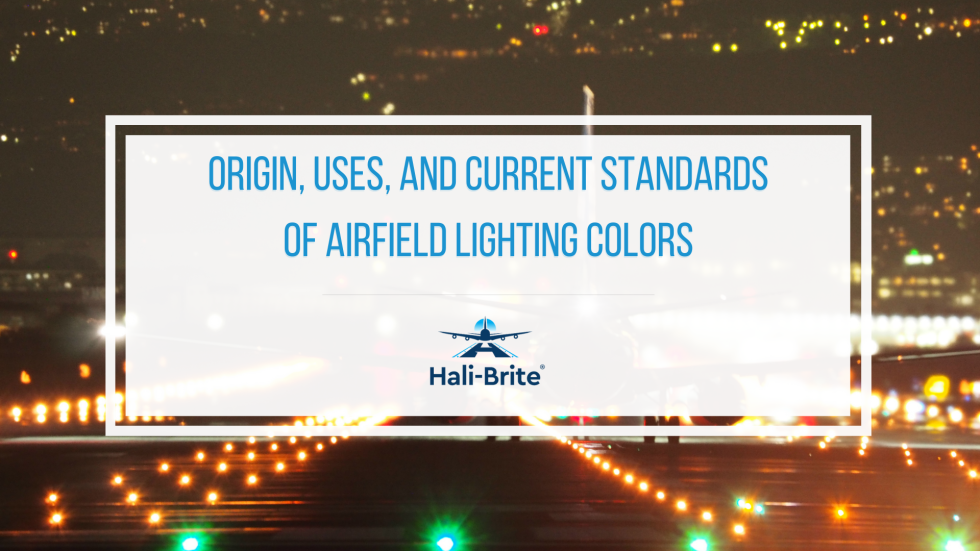A variety of colors illuminate airfields at night. These lights, though, are not installed for aesthetic purposes. Rather, they are used to ensure safety during aircraft operations.
Airfields are equipped with navigation lighting aids, each emitting specific light color to provide pilots with crucial information and help them safely navigate in conditions with low visibility, such as nighttime. Here, you’ll learn the history of airfield lighting colors and the standard color specifications for each airfield lighting aid specified by the Federal Aviation Administration (FAA).
History of Airfield Lighting Colors
Early aviators had no airfield navigational aids at their disposal. In order to navigate, they relied on road maps and visual landmarks seen outside the cockpit window. However, these visual aids were only useful during daytime flights, making night navigation extremely risky.
In 1919, US Army Air Service Lieutenant Donald L. Bruner introduced the use of bonfires as a navigation aid to help pilots locate runways during night flights. It served as the first recorded artificial beacon used in airfields. The bonfire method was then proven by Jack Knight, an airmail pilot, in 1921 when he flew from North Platte to Chicago all night and safely landed in a dark prairie with the help of the lighted bonfires in the area.
The bonfire method was replaced by airway beacons in 1923. Airway beacons were rotating lights placed on top of towers and positioned 15 to 25 miles apart from each other. The rotating beacon flashed white lights in a certain sequence, enabling the pilots to recognize their location. Two additional lights were mounted below the rotating beacon. One of them was pointing toward the last tower, while the other was pointing to the next field, creating a sort of aerial roadway. Green lights were utilized to indicate an official or emergency field, while red lights are for dangerous or unavailable airfields.
In 1926, the Air Commerce Act was passed to establish regulations for safe and efficient aircraft operations. The law mandates the federal government to develop and maintain navigational aids to improve airfield safety. As a result, more beacons were produced and placed along runways. By 1946, over 2,000 airway beacons were operating in airfields around the country.
As technology progressed, new navigational aids with more advanced features emerged, replacing traditional beacons. In 1973, the last operational airway beacon was shut down. Airfields nowadays use rotating beacons, such as Hali-Brite’s Airport LED Rotating Beacon L-801A(L), along with other visual aids like taxiway and runway lighting.
Current Airfield Lighting Color Standards
Each airfield lighting equipment emits a distinct color, enabling pilots to identify them during navigation, landing, and takeoff, especially at night. Here is a list of airfield lighting equipment with their corresponding FAA color specifications:
Runway Edge Lights
Runway edge lights are installed on each side of the runway, forming two straight lines parallel to the runway centerline. They emit a steady white light. In the last 2,000 ft (610 m) of the runway, however, the light becomes steady yellow, indicating the caution zone.
Threshold/Runway End Lights
Threshold/runway end lights indicate the end of a runway. Typically, airfields use bidirectional lights, which emit green lights outward from the runway, indicating the landing threshold for arriving aircraft, and red lights in the opposite direction, marking the end of the runway for departing aircraft.
Runway Centerline Lights
Runway centerline lights are uniformly spaced straight line lights at 50 ft (15 m) longitudinal intervals placed along the centerline of the runway. They emit white color until the final 3,000 ft (900 m) portion of the runway. From there, alternating red and white are installed for the next 2,000 ft (600 m). The last 1,000 ft (300 m) of the runway has red centerline lights, warning the pilot of the approaching runway end.
Taxiway Edge Lights
Taxiway edge lights are omnidirectional blue lights installed in taxiways and aprons. They are positioned at 2 ft (0.6 m) to 10 ft (3 m) from the edge of the taxiway pavement, providing pilots with visuals at night or in any conditions with low visibility while taxiing in the airfield before takeoff or after landing.
Rotating Beacons
Airfield rotating beacons emit light alternating white and green flashes at any point throughout 360 degrees in azimuth with a frequency of 22 to 26 flashes per minute (fpm). Rotating beacons enable pilots to identify the location of an airfield.
Get All Your Airfield Lighting Needs With Hali-Brite
If you need assistance with airfield lighting, Hali-Brite is here to help. All of our lighting products strictly follow the FAA airfield lighting color standards. We also guarantee that our airport lighting systems are of the highest quality and durability. Call us today at (218) 454-0956 or contact here to get your free quote.


